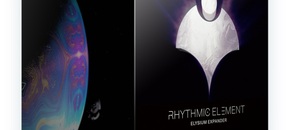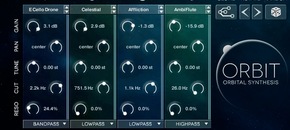ELYSIUM is an organic motion synthesizer from Wide Blue Sound, creators of Orbit and Eclipse.
Wide Blue Sound specialise in making synths with great controllable movement and texture. Aimed mainly at media composers the libraries are also useful well beyond that sphere.
ELYSIUM is a Kontakt instrument. It’s a layered combination of two engines: a tuned percussive sound engine and a synth engine. They combine neatly in the creation of pulsing, rhythmic soundscapes and riffs, using deep, rich multi-samples of various acoustic and digital hardware.
Synth Engine
The Synth engine is an evolution of the previous two libraries, so I won’t dive too deep here. In essence, it’s a four-channel synth, with each channel sequenced through rhythmically. Each channel has either the same or different sound sources, and the stepping through of each channel creates the motion in the sound. The sound of each channel can be initially sculpted with eq and filter, pan and level controls. There are three very different ways to play the sounds back; Pulse, Chop and Flow. Pulse is a fast envelope type sound. Chop is more like a sliced sound, or square wave envelope. And flow is a slower crossfade between the channels, giving a more pad-like sound. Hit a note, and the host-synced tempo plays a pulsing rhythm back on that note. Hit a chord, and it plays a chordal rhythm.
Percussion Engine
The second engine is a source of tuned percussive sounds. There’s only one sound source in this engine, selectable in the same way as the synth engine. But there are many quick tweaks you can make to gently modulate and evolve the sound, to keep it interesting to the ear. My favourite of these was the Flux parameter, which cleverly takes samples from nearby zones in Kontakt, and pitch shifts them to the same note. So you’re always getting one-note, but the timbre of the note is constantly changing, making it a LOT more interesting to the ear. There are two more parameters I liked – the Morph and Bass parameter, which added different sound sources to the channel and flicked between them to create more variation.
The quality of sounds sampled in both engines is faultless. Well tuned, rich, and a good variety of timbres. So you’re not lacking in choice to start with.
Updated Browser
I really liked the updated browser to pick the sounds. It’s a lot more ergonomic and speedy in selecting the sounds you want. You can choose the sound sources for all four channels at once, without having to leave the browser page, select another channel, and go back to the browser page. The sounds are all listenable without selecting, so you can demo the sounds as they compare and contrast with the other channels immediately. You can filter the sound sources by mood or instrument (Dreamy, Bass, for example). Another fantastic tool in the browser is the slightly AI random generator that will select the sources for you depending on the mood you choose and will keep selecting new sources until you stumble upon something you like. Very useful!
Motion
The true beauty of ELYSIUM, as with Orbit and Eclipse, is the ergonomic, yet deeply malleable modulation system that creates a TON of movement within both the effects and the treatment of the sound engines. This, to me, is where ELYSIUM shows its strength.
Phase Sequencer
Before we even get to the overall modulation and FX pages, there’s a phase sequencer on the first window of the GUI. The phase sequencer is a melodic note sequencer, accent, pitch and action (ratcheting, fades, etc.) sequencer. You can also sequence the order of each channel being played on both the percussion and synth engines. You can change the overall step length, and the step rate for each channel separately, which is very useful. I think they missed a beat with a couple of things here; It would have been over-the-top incredible polyrhythmically had we been able to change step length independently per channel – the percussion to 15 steps while keeping the synth engine at 16, for example. Also, I kept longing for an option where the synth engine arpeggiated if I hit a chord, rather than playing a straight chord.
Tide
A new addition to Wide Blue Sounds modulation options is the tide module. This is a looping Attack Decay envelope assigned to the levels of both, or either engine. This enables some nice rises, falls, ”breathing’ or pumping of the sound as a whole. It can be very slight and subtle, or full volume to total silence. A lot of scopes here!
FX and Modulation
The FX page gives you options of 7 built-in FX modules for each engine and the master channel. Almost all of Kontakts FX algos are in here in some form or another – delays, reverbs, distortion, dynamics, modulators and so on. You don’t need anything else! A standout addition that shows WBS have been thinking carefully about sound quality is the addition of the convolution reverb samples from some lovely sources (think EMT, Bricasti and Lexicon). It’s the little things like this that add up to make a really superb sound coming out of the library.
But the motion page is where you get PEAK modulation options. There are six modulation slots, from where you can modulate a SHED load of parameters, from the separate effects on each channel to the parameters of the separate engines to the overall master channel. You can create some lush, subtle ever-evolving movement, to absolute mangled craziness, and it’s all clearly laid out, and easily accessible. I found myself wishing there were more than six modulation slots, as I was using them all up almost immediately. I loved putting them on the percussion engine, changing the length of the sample, the morph and bass controls, to create a lively, breathing, percussive movement. Extremely inspiring sounds!
Conclusion
Focussing on giving the user tight control of the rhythmic motion and pulsing within Synth sounds, Wide Blue Sound have found themselves a strong niche within the Kontakt world.
ELYSIUM is an evolution of their GUI and a development of the engine running their sounds. And this evolution is a big leap forward in terms of usability and sound quality. Plus the colour is gorgeous… Very impressed and highly recommended!
Original Source - AudioNewsRoom.net



